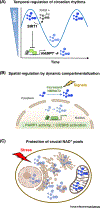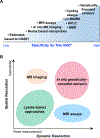Location, Location, Location: Compartmentalization of NAD+ Synthesis and Functions in Mammalian Cells
- PMID: 32595066
- PMCID: PMC7502477
- DOI: 10.1016/j.tibs.2020.05.010
Location, Location, Location: Compartmentalization of NAD+ Synthesis and Functions in Mammalian Cells
Abstract
The numerous biological roles of NAD+ are organized and coordinated via its compartmentalization within cells. The spatial and temporal partitioning of this intermediary metabolite is intrinsic to understanding the impact of NAD+ on cellular signaling and metabolism. We review evidence supporting the compartmentalization of steady-state NAD+ levels in cells, as well as how the modulation of NAD+ synthesis dynamically regulates signaling by controlling subcellular NAD+ concentrations. We further discuss potential benefits to the cell of compartmentalizing NAD+, and methods for measuring subcellular NAD+ levels.
Keywords: CD38; nicotinamide mononucleotide adenylyltransferase (NMNAT); nicotinamide phosphoribosyltransferase (NAMPT); poly(ADP-ribose) polymerase (PARP); sirtuin.
Copyright © 2020 Elsevier Ltd. All rights reserved.
Figures



References
Publication types
MeSH terms
Substances
Grants and funding
LinkOut - more resources
Full Text Sources
Other Literature Sources
Research Materials
Miscellaneous

